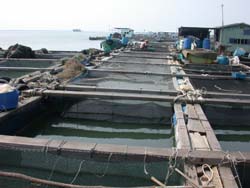
Environmental chemists at CAS recently reported their latest research results on the occurrence of persistent halogenated hydrocarbons (PHHs) in consumer fish of China. Most of the fish fared well in their tests, showing no significant exposure risks to human health, but seawater farmed fish had PHHs levels high enough to invoke alert.
PHHs, such as organochlorine pesticides (OCPs), polychlorinated biphenyls (PCBs) and polybrominated diphenyl ethers (PBDEs), are chemical substances that can persist in the environment and bioaccumulate through the food web. They are extremely difficult to degrade and can be transported over a long distance to regions where they have never been used or produced, posing great challenges to human health and the global environment. In 2001, the Stockholm Convention was signed in Sweden under the joint efforts of over 150 nations, including China, vowing to reduce and eliminate the releases of 12 persistent organic chemicals, with OCPs and PCBs on the list.
As revealed in a recent issue of
Environmental Science & Technology (ES&T), a research team from the CAS Guangzhou Institute of Geochemistry (GIG) sampled 13 consumer fish species (a total of 390 individuals) from a major fish-farming region in southern China's Guangdong Province. Analysis showed that the prominent PHH residues were from variants of DDT, HCH, PCB and PBDE, with their median levels being 6.0, 0.50, 0.10, and 0.15 ng/g wet weight respectively. These levels are "moderate" compared to the global values and well below the limits enforced by the U.S. Food and Drug Administration and the Chinese government. That is to say, fish from China are no more hazardous than those from other parts of the world. Meanwhile, the paper pointed out the necessity to limit the consumption of seawater farmed fish, on the basis of a more conservative risk assessment criterion developed by the U.S. Environmental Protection Agency.
Snubnose pompano and crimson snapper, both cage-cultured seawater fish, fared the worst in the analysis, while freshwater carp and tilapia contained relatively low levels of PHHs. For snubnose pompano, the authors recommend no more than one meal per month, but they say that consumers could safely eat more than 16 meals per month of freshwater farmed fish and wild-caught seawater fish.
About the implications of the new study, Eddy Y. Zeng (ZENG Yongping), one of the authors of the paper and head of the research group, says "People should eat fish; just be a little selective." "I would eat less marine farmed fish than freshwater farmed or wild fish," he remarked.
The results were published on the website of
ES&T on February 7 with expert reviews from Prof. Samuel Luoma, biologist form the U.S. Geological Survey. He spoke highly of the research to have done "a very measured job of interpreting the data," which "suggest there are not the concerns that many people are worried about with farm-raised fish…that's really good news."
Started in late 2004, the study is the first systematic assessment over contaminants and health risks for Chinese consumer fish, according to Zeng. Further studies will be carried out on other kinds of seafood as well as the sources of contamination, he added.
Eddy Zeng is now conducting research at GIG. He got his Ph.D. degree in chemical physics from the University of Southern California, U.S. Before being recruited to GIG through the CAS-hosted Bairen Program in 2004, he was working as the principal investigator of the chemistry group at the Southern California Coastal Water Research Project Authority from 1992 to 2003. He was appointed as the director of the State Key Laboratory of Organic Geochemistry in January 2006.





